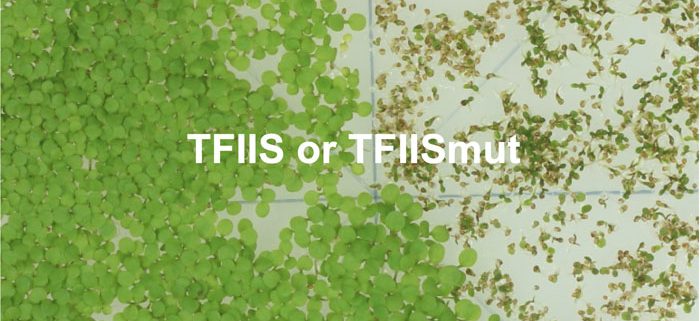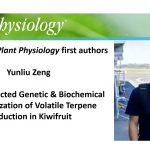RNA polymerase II transcription: cleave to elongate
Antosz et al. show that the ability of RNA polymerase II to cleave transcripts is required for proper transcription and plant growth.
Wojciech Antosz and Klaus Grasser, University of Regensburg
https://doi.org/10.1105/tpc.19.00891
Background: In plants as in other eukaryotes, nuclear RNA polymerase II (RNAPII) transcribes protein-coding genes to produce mRNAs, which are then translated to produce proteins. During transcription, RNAPII associates with various elongation factors that ensure efficient mRNA synthesis. One of these assistant factors is TFIIS, which deeply inserts a highly conserved acidic hairpin domain into RNAPII reaching to the active center of the enzyme. Thereby, TFIIS strongly stimulates the otherwise weak intrinsic RNA cleavage activity of RNAPII that is required to reactivate the enzyme in cases of transcriptional arrest. However, a TFIIS mutant variant (TFIISmut – two amino acid substitutions within the acidic hairpin) is a potent inhibitor of the RNA cleavage activity.
Question: The role of RNAPII-mediated transcript cleavage has not been studied in plants. Therefore, we expressed TFIISmut in Arabidopsis to monitor the molecular and phenotypic consequences of RNA cleavage inhibition.
Findings: Constitutive expression of TFIISmut in mutant plants lacking wild-type TFIIS caused lethality, demonstrating that complete inhibition of the RNA cleavage activity impairs viability. Transient expression of TFIISmut results in severe plant growth defects, wide changes in gene transcription and massive redistribution of RNAPII towards transcriptional start sites at the position of the first nucleosome. These findings indicate that the inhibition of the RNA cleavage activity of RNAPII causes stalling of the polymerase at many genes during early transcript elongation. Thus, RNA cleavage by RNAPII is commonly required for correct transcriptional output and proper plant growth.
Next steps: Strikingly, RNAPII accumulation close to the transcription start site occurs in a subset of transcribed genes. Therefore, it might be interesting to identify the parameters (e.g. chromatin structure, inducibility and expression level) that distinguish these genes from unaffected genes.
Wojciech Antosz, Jules Deforges, Kevin Begcy, Astrid Bruckmann, Yves Poirier, Thomas Dresselhaus and Klaus D. Grasser (2020) Critical Role of Transcript Cleavage in Arabidopsis RNA Polymerase II Transcriptional Elongation. Plant Cell. https://doi.org/10.1105/tpc.19.00891




